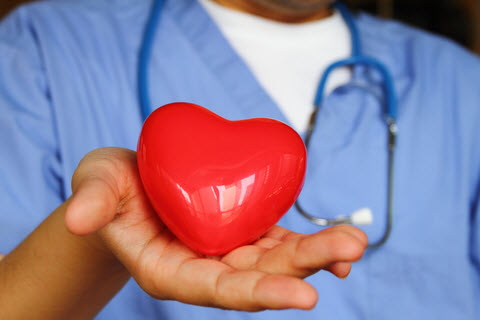February has different implications for people. For children, it is Valentine's Day in school. For them, February means cutting out paper hearts and giving cards to friends in class. For others, it can mean one of the harshest months of winter. For them, February can feel brutally cold and unforgiving. For those living in places without brutal winters, February may feel just like any other month, but for the Center for Disease Control and Prevention February is American Heart Month.
American Heart Month is designed to encourage people to take steps towards better heart health. The CDC is working together with Million Hearts to reduce heart attacks and strokes in the United States. The first step on this journey is making sure the heart is healthy and heart disease managed.
What is Heart Disease?

For American Heart Month, manage heart health and address any heart disease concerns.
The heart pumps blood throughout the body, providing its vital systems with oxygen and nutrients. Heart disease refers to an array of illnesses that may affect the heart's health and in turn, the rest of the body's health. A healthy heart pumps blood efficiently and adequate oxygen and nutrients are supplied to organs. Without healthy blood flow, the body's systems do not function optimally. This can cause something as innocuous as feeling fatigued, but it can also cause a heart attack or a stroke.
Types of Heart Disease
Types of heart disease differ in terms of severity and health effects. Arrhythmias cause the heart to pump erratically, providing inconsistent circulation of nutrients and oxygen. A minor arrhythmia may be of less concern, however a more severe arrhythmia may require a treatment plan from a doctor.
A blood vessel disease, such as coronary artery disease, indicates that blood vessels are blocked, stiffened or narrowed. These changes prevent optimal blood flow to the heart, brain and other internal systems.
Congenital heart defects are defects that a person is born with. Doctors should already be aware of and monitoring patients with this form of heart disease. Consistent monitoring ensures that the heart is functioning properly despite abnormalities.
Symptoms
Symptoms of heart disease will vary based on the type, however, The Mayo Clinic advises symptoms may differ for men and women. For blood vessel diseases, men may feel chest pain, while women can have shortness of breath. Other symptoms in women include extreme fatigue and nausea. Arrhythmia symptoms include any major change in heart rate, chest pain, or dizziness. Congenital heart defect symptoms depend on the defect, but a person with a heart defect should be monitored for any changes in their breathing and fatigue levels after exercise.
Caring for a Patient with Heart Disease
If you are caring for someone who is living with heart failure - you owe it to yourself, and the one you are caring for, to learn more about the disease and ways to manage the disease. Heart failure nurse Beverly Tuomala, BSN, RN, CHFN, can help you do so in her four part series, Living with Heart Failure.
- Living with Heart Failure: Identifying the Problem
- Living with Heart Failure: Medications and Therapies
- Living with Heart Failure: Sodium/Fluid Restriction
- Living with Heart Failure: Putting it all Together
Monitor Cholesterol and Blood Pressure Levels
The first step in caring for a person with heart disease is monitoring blood pressure and cholesterol levels. Caregivers should make sure that the patient has regular check-ups with their physician to ensure that negative changes to either level are caught early and remedied. A physician's next steps will differ based on a patient's mobility and heart condition, but physicians should be consulted before making any changes to diet or exercise regimen.
Increase Exercise
A part of controlling blood pressure and cholesterol levels is exercise. Taking a patient's abilities into account, caregivers should work with a trusted physician to find an exercise regimen that makes sense for the senior. Depending on mobility, walks or tai chi are a good option to start, but some seniors may enjoy light strength training or water-based activities, such as swimming and water aerobics.
Balanced Meals
An important part in lowering cholesterol and blood pressure is creating a diet that includes healthy oils, and is high in fruits and vegetables while being low in saturated fats, red meats, and sodium. mmLearn.org offers videos on nutrition to help caregivers get started creating balanced and healthy meal plans for seniors.
Decrease Stress Levels

Reducing stress levels can help decrease high cholesterol and blood pressure.
According to the American Heart Association, stress increases high blood pressure and cholesterol levels, which in turn increase the risk of heart disease. If there are high levels of stress in the patient's life, find activities to relieve that stress. These may be activities that the caregiver can do with her patient, like tai chi, which has the additional exercise benefits, or going for walks. If the senior enjoys painting or other calming recreational activities, these activities can be used to reduce stress levels as well. It may take time to find an activity that fits, but the additional health benefits of a calming activity can improve heart health.
Know What to Do
In the event of a heart attack or a stroke, knowing what to do can make all the difference. This caregiver video offers information on strokes, including how to identify and prevent them.
As with all of the suggestions above, caregivers should consult a trusted physician to create healthy changes in diet and exercise. This will ensure that changes are effective and safe, while promoting a healthier, happier heart.
mmLearn.org offers a large library of free videos for caregivers of older adults, covering topics pertaining to senior care. Whether you are a healthcare professional or a family caregiver, if you are caring for an older adult we know that you will find mmLearn.org an essential learning and guidance tool for all of your caregiver training needs.
Access our free online caregiver videos
